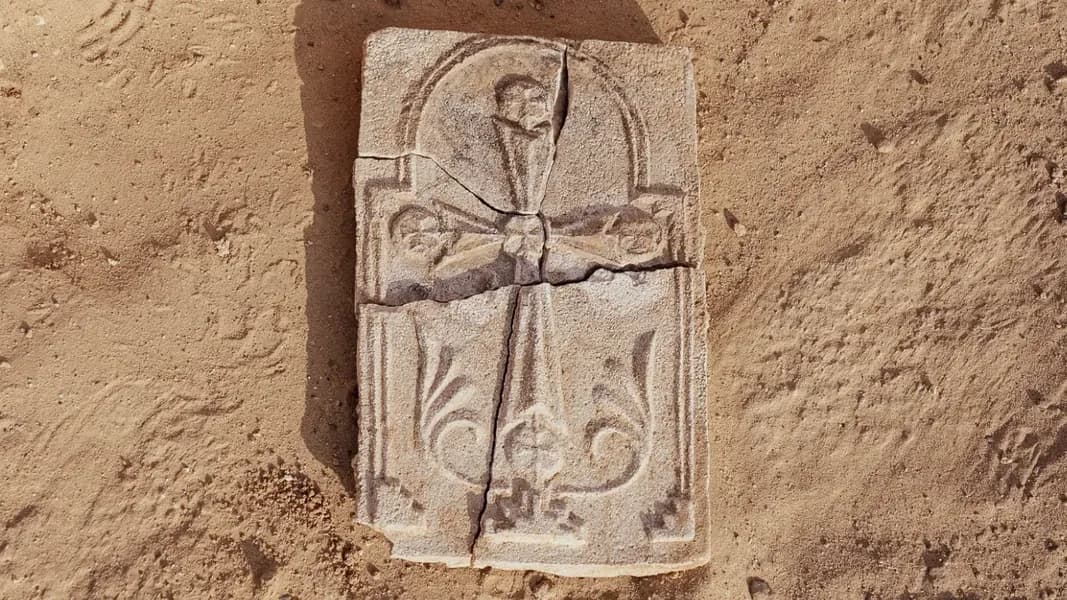Archaeologists have discovered an artifact that offers "proof" of an enduring Christian monastic presence 1,400 years ago on a small island in the Persian Gulf.
A plaster cross moulded on a plaque was found at an archaeological site on Sir Bani Yas, an island about 110 miles southwest of Abu Dhabi, the capital of the United Arab Emirates, reports Crux, the Rome-based Catholic news agency.
The site on Sir Bani Yas was first excavated in the early 1990s and found to contain buildings that archaeologists identified as a church and monastic living quarters, though up to now it was believed that the buildings only served as temporary accommodation.
“This is a very exciting time for us, because in the past, we have always assumed that these houses were part of a dispersed monastic settlement, but we never had concrete proof that they were actually inhabited by Christians,” says Maria Magdalena Gajewska, an archaeologist working with the Abu Dhabi Department of Culture andTourism.
“We have now proof that these houses were indeed part of a Christian settlement.”
The artifact – measuring about 10.6 inches long, 6.7 inches wide and a little less than an inch thick – is decorated with symbols indicating that the community that lived there belonged to the Church of the East, which began to split from the Roman Church when the former refused the condemnation of Nestorian heresy at the Council of Ephesus in 431 and did not recognise the Council of Chalcedon in 451.
The monastery on Sir Bani Yas was was part of a network stretching across the area of modern-day Gulf states, including Kuwait, Iran and Saudi Arabia, Crux reports.
Gajewska said the artifact was discovered as part of the first major excavations since the site was first identified and which were also the first excavations of the monastery’s living quarters.
“The site, the monastery, also included the first houses – there are about nine of them, to the north and northwest of the main church,” Grajewska said in a video produced by the Abu Dhabi Media Office to publicise the find.
“We currently believe that this is where more senior monks lived and had periods of seclusion, practiced prayer, and mental and spiritual discipline, before reconvening with their brothers at the monastery,” Grajewska said.
The chairman of Abu Dhabi’s Culture and Tourism Department, Mohamed Khalifa Al Mubarak, called the discovery on Sir Bani Yas “a powerful testament to the UAE’s profound and enduring values of coexistence and cultural openness”.
Pope Francis visited the United Arab Emirates, where he signed the landmark Document on Human Fraternity with the Grand Imam ofAl-Azhar, Sheikh Ahmed el-Tayeb, in Abu Dhabi on 4 February 2019.
The Vatican recently approved a new liturgical calendar for the Apostolic Vicariate of Southern Arabia (AVOSA) while also designating new patrons for the Catholic Church across the Arabian Peninsula.
The decision marks a historic moment for Catholics in the region, acknowledging the deep roots of Christianity in a land often overlooked in the broader history of the Church.
In the Gulf, the Church exists as a pilgrim community, composed largely of migrant workers from every continent who live their faith amidst societies shaped by Islam.
This new calendar, far from being a mere list of commemorations in a region where the Church is young, scattered and often hidden, strives, instead, the Vicariate explains, to be a sign of belonging, of memory and of hope.
RELATED: Vatican approves new liturgical calendar and patron saints for Arabian Peninsula
Photo: The stucco cross discovered at an ancient monastery in the United Arab Emirates. (Credit: Department of Culture and Tourism Abu Dhabi.)
















